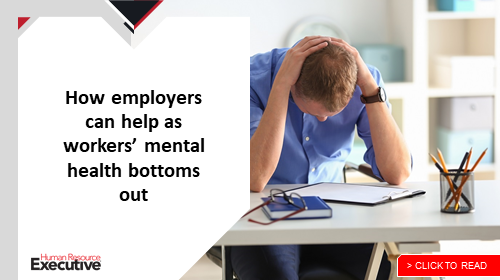The COVID-19 pandemic has led to a dramatic increase in major symptoms of anxiety and depression, heightening the need for meaningful mental healthcare and support, which was in short supply even before the pandemic. Leading organizations are highly focused on this issue, especially as they look to retain and engage key employees amid a tight labor market. In recent research from Willis Towers Watson, two of three companies reported they will prioritize access to mental health solutions and have made it a top priority to increase the use of mental health programs.
But how do organizations effectively address mental healthcare and support? The answer can’t rely on Employee Assistance Programs (EAPs) alone, as utilization still remains under 5% for most employers. Instead, employers can drive utilization and sustained engagement of mental health solutions by adopting behavioral economics precepts, taking advantage of the way we process decisions. Here’s how:
- Make it easy to get mental healthcare.
One of the most powerful ways to increase utilization of mental health services is through thoughtful choice architecture, making the desired behavior as easy as possible. Employers can remove the cost barrier by offering mental health services with low or no out-of-pocket costs and can enhance program visibility through links on popular employee sites, home mailers and single sign-on access. Employees in crisis may lack energy and cognitive focus and should not have to rummage through old mailers or navigate through several clicks to find a mental health benefit!
See also: Your insider look at the upcoming Health & Benefits Leadership Conference
 Employers can simplify the appointment-making process through scheduling flexibility and facilitating access to providers that offer text or email appointment reminders, automated return visits and the option to book follow-up appointments. Employers may also consider an EAP model that includes a higher number of sessions so employees can get all necessary care without transitioning to a new provider and paying out-of-pocket costs.
Employers can simplify the appointment-making process through scheduling flexibility and facilitating access to providers that offer text or email appointment reminders, automated return visits and the option to book follow-up appointments. Employers may also consider an EAP model that includes a higher number of sessions so employees can get all necessary care without transitioning to a new provider and paying out-of-pocket costs.
- Promote mental health resources prominently and repeatedly.
Repetitive communications will keep mental health resources top-of-mind for employees when they need support, rather than relying on employees to recall information provided during open enrollment. Communication campaigns can bring attention to resources through various modalities such as email campaigns, timely intranet posts on specific mental health issues and mailers, in addition to on-site methods like posters and break-room informational screens on TVs.
- Decrease stigma through social networks.
Unfortunately, many neglect their mental health needs because of real and perceived negative reactions from friends, family or the community. Employers can use social networks, or virality, to change the perception of seeking mental health support since people look to others for behavioral cues.
For example, employers can underscore the number of colleagues that a program helped and how many continue to benefit through sustained participation. Employers can normalize accessing mental healthcare by including testimonials from employees and leaders in communications and personal experiences in webinar or town hall settings. Employers can also provide a platform, like Slack or Yammer, to encourage employees to share their mental health journeys. Hearing other employees and influential leaders acknowledge common struggles such as anxiety, depression and burnout can encourage employees to address their own mental health concerns.
- Harness intrinsic motivation.
Intrinsic motivation is a powerful driver of human behavior and can facilitate acceptance and use of mental health support. Employers can gain better understanding of employees’ personal goals through surveys and focus groups, use these insights to design policies to overcome barriers to mental healthcare and deploy communications that emphasize how addressing mental health challenges helps employees achieve their personal objectives. Employees can be motivated by the expectation that getting mental healthcare can increase the opportunity to have new experiences, achieve their highest potential, feel calm or be present with family and loved ones.
 Related: 7 employer strategies to support growing mental health challenges
Related: 7 employer strategies to support growing mental health challenges
- Recognize that employees overestimate their ability to overcome obstacles on their own.
People have optimism bias and overestimate their ability to “tough it out” and get better without professional assistance. Employer communications can note that even the most successful people need help at times, and emphasize the opportunity to succeed. Employers can also drive sustained engagement by delivering encouraging messaging on accomplishments and milestones.
- Communicate effectively through loss aversion.
People hate losses much more than they like gains. Employers can leverage this loss aversion by highlighting the potential loss of the opportunity to live a full life if mental health issues are not addressed. Messaging can focus on the time that will no longer be lost to worrying and negative feelings. For lower-risk employees who may be inclined to deprioritize mental health, employers can communicate potential losses suffered by not getting help for smaller issues, showing how the severity and consequences of mental illnesses can escalate. Although focusing on losses deviates from channeling optimism and intrinsic motivation, deploying seemingly contradictory behavioral economics tactics can achieve higher engagement by appealing to the different ways we process information.
- Use narrative to convey the potential impact of getting needed care.
 People are more moved to action by powerful stories than by statistics. Employers can share employee testimonials to promote use of mental health resources, taking advantage of our inherent “narrative bias.” Stories that highlight personal journeys of diverse individuals with different mental health challenges can help employees feel that the resources are relevant to their own life circumstances. Personal stories told directly by senior leaders foster a supportive culture.
People are more moved to action by powerful stories than by statistics. Employers can share employee testimonials to promote use of mental health resources, taking advantage of our inherent “narrative bias.” Stories that highlight personal journeys of diverse individuals with different mental health challenges can help employees feel that the resources are relevant to their own life circumstances. Personal stories told directly by senior leaders foster a supportive culture.
See also: Here’s your chance to recognize an outstanding HR leader
- Use framing to encourage employees to obtain mental health services.
Since people consider options in context and not independently, employers can highlight the value of utilizing digital mental health solutions through framing. Specifically, communications can frame the use of a digital solution as an easier first step than trying to navigate the system and find a therapist on their own. To initiate first-time usage, employers can frame the time required to register or take an initial assessment as no longer than it takes to complete a simple task, like filling your gas tank. It’s not hard to frame costs of getting mental health care as low, since employees can often access free therapy sessions and resources through the EAP.
Conclusion
The pandemic has dramatically increased the need for mental healthcare, and available digital and virtual solutions have increased the capacity to deliver this much-needed care. By using behavioral economics precepts, employers are uniquely positioned to reduce stigma and drive engagement in these new mental health services.
The post 8 ways behavioral economics can drive mental healthcare adoption appeared first on HR Executive.